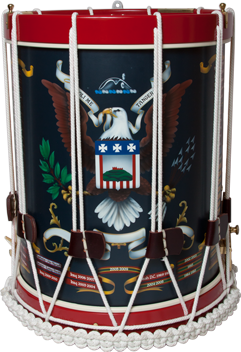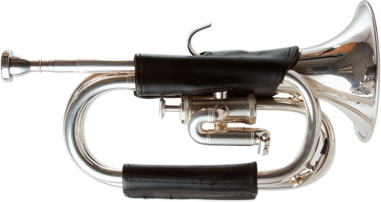The Fife

The fife was one of the instruments used during the Revolutionary War to tell Soldiers what to do on the battlefield. Its sound is very high-pitched and squeaky, which allows the sound to travel very far and be heard over the noise of the battle. It is made of dark wood and has metal pieces at the ends to help hold it together. It looks a lot like a flute or piccolo, except there are no metal keys to change notes – only open holes. During the Revolutionary War, fifes had 6 holes, but now we play fifes with 10 holes; one for each finger! This lets us play music that is more fun and interesting.
The Snare Drum and Bass Drum
Drums are one of the earliest instruments know to humans. Some drums date back to 6,000 BC! The drums we use are known as rope-tensioned drums and are like the drums that were used during the Revolutionary War. They are called rope-tensioned because the rope that is threaded from the top rim to the bottom rim keeps the drum together and helps keep the drum heads tight.

We use two different styles of drums; snare drums and bass drums. Each has a unique sound and when played together make really cool beats. The snare drum is higher in pitch and has a buzzy sound. We play on the top drumhead with wooden drumsticks and carry them with a leather strap. The bass drum sounds deep and boomy and is played with special sticks called bass drum mallets. The bass drum is also carried with a leather strap but is played on its side and on both drum heads.
Regular band instruments can make a variety of different pitched sounds - or scales. Our drums are different because they can only play one pitch. The notes we play on ours are called rudiments and when joined together make very interesting patterns.
One of the neatest things about our drums is the beautiful painting on the front. This design is the military crest of the Old Guard - the Army unit that we are a part of. This unit is the oldest active Infantry unit in the entire Army! The painting also has little ribbons on each side listing all of the battles that the Old Guard fought in. You can tell a lot about the Old Guard just by looking at our drums!
The One-Keyed Flute

This is the one-keyed flute. Does this instrument look like one you have ever seen? You may be more familiar with the look and sound of the modern silver flute. This one-keyed flute we play is made of wood with imitation ivory as decoration at both ends and at the joints (the places on the instrument where it is put together). Due to its material, wood, this flute sounds more mellow-less clear and crisp-than the modern silver flute. The flute was the most popular of all wind instruments around the courts of Europe in the 18th century, a period of history known as the Baroque. That
is why today, you may hear the one-keyed flute called the baroque flute.
This flute is also often called the traverso, an Italian word referring to the way we hold the flute out to the side and blow across the tone hole (not directly into it) to produce sound. We perform historical music on our one-keyed flutes that would have been played and heard over 200 years ago!
The Vented Trumpet

This is what a trumpet would have looked like 200-400 years ago. As you can tell, they were very different from what you see today. The trumpets were much longer and did not have any valves to change notes because valves hadn't been invented yet! Because of this, the player could only use air and his or her lips to change between notes. The lack of valves also made the trumpet much easier for the soldier to play with one hand while riding on horseback, which most of the trumpeters would have done. Trumpets in the military were used to relay signals and instructions from their commander to the troops and to entertain and boost the soldier's morale. Today, our Historical Trumpets perform signals and 17th and 18th century music, bringing these musical traditions back to life!







